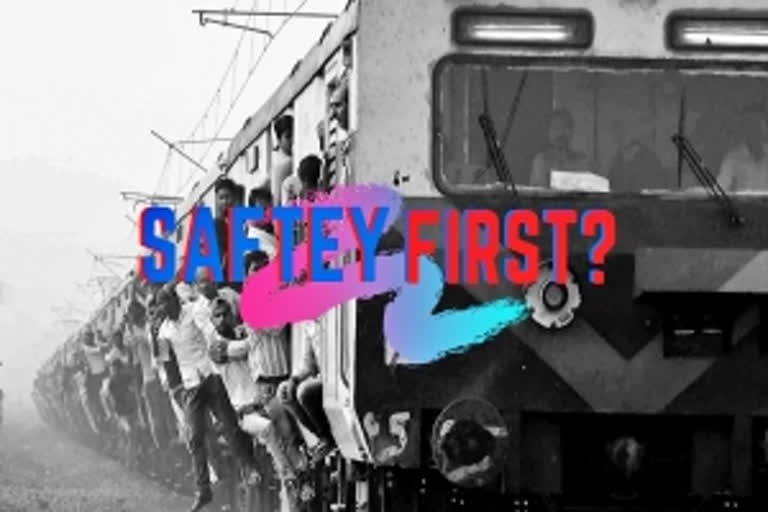Hyderabad (Telanagana): Is the Indian Railways putting passenger safety first? Was there any improvement in the construction of new lines, gauge conversion or operational cost control? The Parliamentary Standing Committee’s reports gave a straight no to these questions.
During the budget presentation three years ago, the former Finance Minister Arun Jaitley proposed allocating INR 20,000 crores per annum for a period of 5 years starting FY 2017-18 to the Rashtriya Rail Sanraksha Kosh. That year, the Union Finance Ministry had raised INR 5,000 crores in support of this proposal. But the situation changed rapidly.
The committee, which alleged that the allocations have been reduced by a quarter and that they are spending only half of this amount. It even claimed that the purpose of the fund is damaged. The slowdown in the construction of new routes, along with a shortage of funds for railway safety, is a concern. While the target was to complete a thousand kilometres long new lines in 2018-19, but only 479 kilometres could be completed.
Though the target has been reduced by half for 2019-20, only 278 kilometres could be finished. It is becoming increasingly clear that if the available funds are drying up, the cost of security is also shrinking. Another important indicator of the poor performance of railways is the Operating Ratio (OR).
The standing committee, which accused the railway board of spending INR 97 for every hundred rupees of revenue and asked the board to control unnecessary expenses and find ways to increase the revenue. The standing committee’s report is directly hinting at the loopholes in the Indian Railways.
Three months ago, the CAG had reported discrepancies in the railways’ financial management.
According to the report, the Indian Railways’ expense to revenue ratio has dropped to a 10-year low during 2017-18. In fact, if the public facility had received the due advances worth INR 7,300 crores from NTPC and IRCON by the time these calculations were done, the OR would have been 102.66 per cent.
The Sudeep Bandopadhyay Committee revealed a year ago that the Indian Railways, which escaped a great fall in a jiffy through these adjustments, has been delaying the critical repairs. It is shocking that there is a 60 per cent personnel shortage in a country where more than 37,000 railway bridges are older than 100 years.
Till 2016-17, the railways were capable of pooling 11 per cent of the total capital through internal resources. The percentage fell to 3.5 in the following three years. The latest Union Budget has proposed to increase the percentage to 4.6 this year. Though nobody knows how feasible this proposal is, it is doubtful how the railways will make train journeys less risky and more comfortable.
The Sam Pitroda Committee had previously proposed allocating INR 8.22 lakh crores towards modernization of Indian Railways. At a time when the national railway system is unable to pool even INR 7,000-8,000 crores annually through its assets, it is doubtful if it will stand the test of time.
With more than 20,000 trains which carry 800 crore passengers every year, the Indian Railways is a lifeline of the nation. Though several surveys have repeatedly addressed the need for a qualitative transformation, the implementation is lacklustre.
The official confirmation of a mere 30 per cent growth in railway infrastructure in the six and half decades of its existence, is an evidence of negligence in expansion.
The number of complaints filed about the poor food quality and lack of hygiene in South Central Railways, is a reflection of the other railway zones’ performance too.
The main reason for this dire state of railways with subpar standards, misused subsidies and compromised passenger safety, is, without doubt, the political system.
The Modi government has rightly realized the role of railways in building the nation and decided to undertake crucial reforms. The Center has already planned to replace the current signalling system and is working towards complete electrification of the tracks by 2023.
But the reforms should not end there alone. A comparison of the European Railway Network released 5 years ago showed that Denmark had the safest railway system. Japan, on the other hand, is renowned for its punctual and technically advanced railway network.
The US and China are pacing ahead with the satellite signalling system which forewarns and prevents dangers on the tracks. Compared to them, our train network looks pale with improper safety measures, lack of technical advances and bad freight services. It is the responsibility of the governments to dispel such a situation.
If the Indian Railways are strengthened with the right amount of reforms and amenities, they can be a boost to the national economy.
Also Read: RPF personnel saves life of man dragged by train in Bengal station



